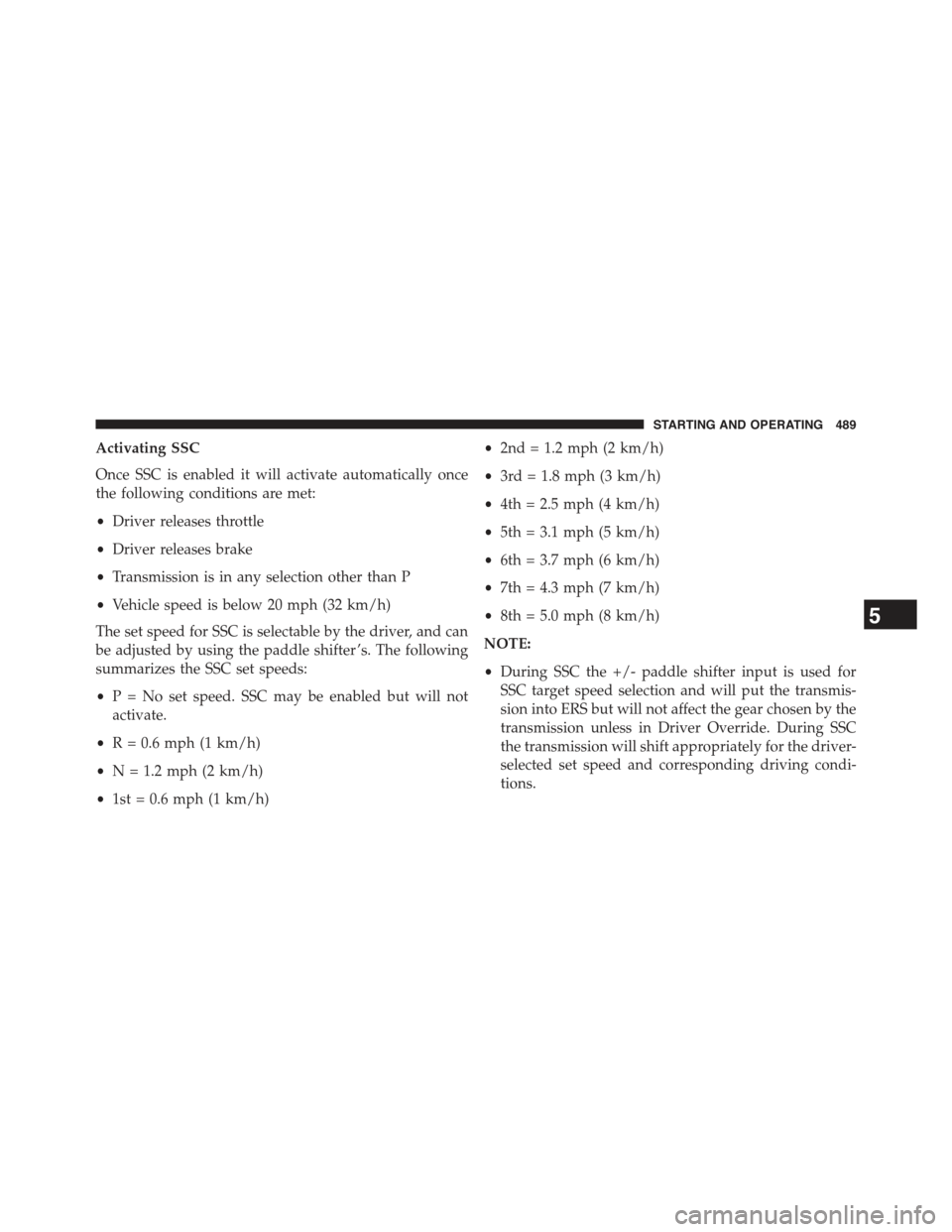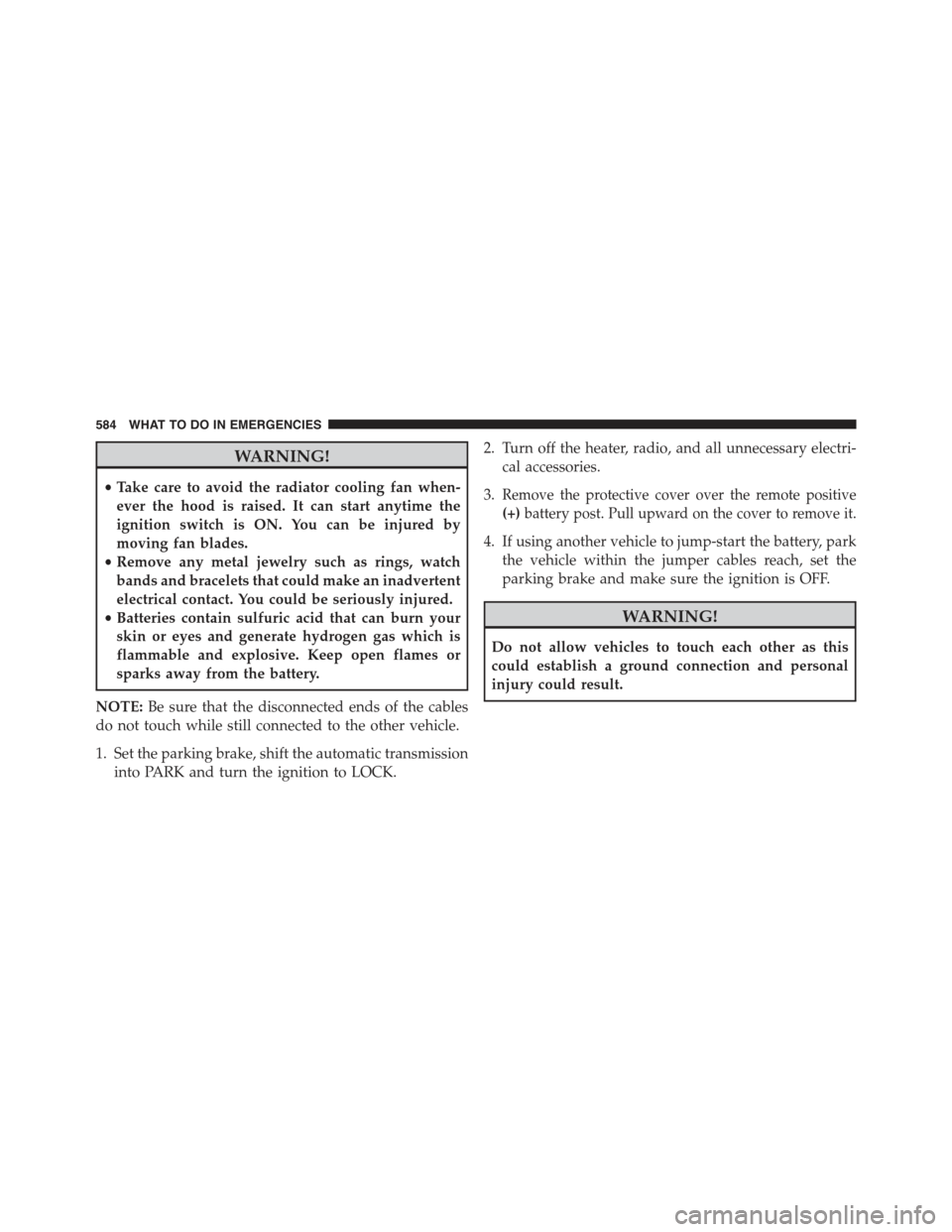Page 487 of 717

•Driver door is closed
Activating HDC
Once HDC is enabled it will activate automatically if
driven down a grade of sufficient magnitude (greater
than approximately 8%). The set speed for HDC is
selectable by the driver, and can be adjusted by using the
paddle shifter. The following summarizes the HDC set
speeds:
•P = No set speed. HDC may be enabled but will not
activate.
•R = 0.6 mph (1 km/h)
•N = 1.2 mph (2 km/h)
•1st = 0.6 mph (1 km/h)
•2nd = 1.2 mph (2 km/h)
•3rd = 1.8 mph (3 km/h)
•4th = 2.5 mph (4 km/h)
•5th = 3.1 mph (5 km/h)
•6th = 3.7 mph (6 km/h)
•7th = 4.3 mph (7 km/h)
•8th = 5.0 mph (8 km/h)
NOTE:
•During HDC the +/- paddle shifter input is used for
HDC target speed selection and will put the transmis-
sion into ERS but will not affect the gear chosen by the
transmission unless in Driver Override. During HDC
the transmission will shift appropriately for the driver-
selected set speed and corresponding driving condi-
tions.
•HDC performance is influenced by the Terrain Select
mode. This difference may be notable to the driver and
may be perceived as a varying level of aggressiveness.
5
STARTING AND OPERATING 485
Page 491 of 717

Activating SSC
Once SSC is enabled it will activate automatically once
the following conditions are met:
•Driver releases throttle
•Driver releases brake
•Transmission is in any selection other than P
•Vehicle speed is below 20 mph (32 km/h)
The set speed for SSC is selectable by the driver, and can
be adjusted by using the paddle shifter ’s. The following
summarizes the SSC set speeds:
•P = No set speed. SSC may be enabled but will not
activate.
•R = 0.6 mph (1 km/h)
•N = 1.2 mph (2 km/h)
•1st = 0.6 mph (1 km/h)
•2nd = 1.2 mph (2 km/h)
•3rd = 1.8 mph (3 km/h)
•4th = 2.5 mph (4 km/h)
•5th = 3.1 mph (5 km/h)
•6th = 3.7 mph (6 km/h)
•7th = 4.3 mph (7 km/h)
•8th = 5.0 mph (8 km/h)
NOTE:
•During SSC the +/- paddle shifter input is used for
SSC target speed selection and will put the transmis-
sion into ERS but will not affect the gear chosen by the
transmission unless in Driver Override. During SSC
the transmission will shift appropriately for the driver-
selected set speed and corresponding driving condi-
tions.
5
STARTING AND OPERATING 489
Page 556 of 717
Towing Tips
Before setting out on a trip, practice turning, stopping
and backing the trailer up in an area away from heavy
traffic.
Automatic Transmission
The DRIVE range can be selected when towing. The
transmission controls include a drive strategy to avoid
frequent shifting when towing. However, if frequent
shifting does occur while in DRIVE, you can use the
Paddle Shift switches to manually select a lower gear.
NOTE:Using a lower gear while operating the vehicle
under heavy loading conditions, will improve perfor-
mance and extend transmission life by reducing exces-
sive shifting and heat buildup. This action will also
provide better engine braking.
Seven-Pin Connector
1—Battery5—Ground2—BackupLamps6—LeftStop/Turn3—RightStop/Turn7—RunningLamps4 — Electric Brakes
554 STARTING AND OPERATING
Page 564 of 717
6. After the shift is completed and the NEUTRAL (N)
light stays on, release the NEUTRAL (N) button.
7. Shift the transmission into REVERSE.
8. Release the brake pedal for five seconds and ensure
that there is no vehicle movement.
9. Shift the transmission back into NEUTRAL.
10. With the transmission and transfer case in NEU-
TRAL, press and hold the ENGINE START/STOP
button until the engine turns off. Turning the engine
off will automatically place the transmission in
PARK.
11. Press the ENGINE STOP/START button again (with-
out pressing the brake pedal), if needed, to turn the
ignition switch to the OFF position.
12. Firmly apply the parking brake.
13. Attach the vehicle to the tow vehicle using a suitable
tow bar.
14. Release the parking brake.
NEUTRAL (N) Switch
562 STARTING AND OPERATING
Page 577 of 717

Jacking Instructions
WARNING!
Carefully follow these tire changing warnings to
help prevent personal injury or damage to your
vehicle:
•Always park on a firm, level surface as far from the
edge of the roadway as possible before raising the
vehicle.
•Turn on the Hazard Warning flasher.
•Chock the wheel diagonally opposite the wheel to
be raised.
•Set the parking brake firmly and set an automatic
transmission in PARK.
•Never start or run the engine with the vehicle on a
jack.
(Continued)
WARNING!(Continued)
•Do not let anyone sit in the vehicle when it is on a
jack.
•Do not get under the vehicle when it is on a jack. If
you need to get under a raised vehicle, take it to a
service center where it can be raised on a lift.
•Only use the jack in the positions indicated and for
lifting this vehicle during a tire change.
•If working on or near a roadway, be extremely
careful of motor traffic.
•To assure that spare tires, flat or inflated, are
securely stowed, spares must be stowed with the
valve stem facing the ground.
6
WHAT TO DO IN EMERGENCIES 575
Page 586 of 717

WARNING!
•Take care to avoid the radiator cooling fan when-
ever the hood is raised. It can start anytime the
ignition switch is ON. You can be injured by
moving fan blades.
•Remove any metal jewelry such as rings, watch
bands and bracelets that could make an inadvertent
electrical contact. You could be seriously injured.
•Batteries contain sulfuric acid that can burn your
skin or eyes and generate hydrogen gas which is
flammable and explosive. Keep open flames or
sparks away from the battery.
NOTE:Be sure that the disconnected ends of the cables
do not touch while still connected to the other vehicle.
1. Set the parking brake, shift the automatic transmission
into PARK and turn the ignition to LOCK.
2. Turn off the heater, radio, and all unnecessary electri-
cal accessories.
3.Remove the protective cover over the remote positive
(+)battery post. Pull upward on the cover to remove it.
4. If using another vehicle to jump-start the battery, park
the vehicle within the jumper cables reach, set the
parking brake and make sure the ignition is OFF.
WARNING!
Do not allow vehicles to touch each other as this
could establish a ground connection and personal
injury could result.
584 WHAT TO DO IN EMERGENCIES
Page 602 of 717

▫Front/Rear Axle Fluid..................640
▫Transfer Case........................641
▫Automatic Transmission................642
▫Appearance Care And Protection From
Corrosion...........................644
!FUSES..............................650
▫Power Distribution Center...............651
!VEHICLE STORAGE....................659
!REPLACEMENT BULBS.................660
!BULB REPLACEMENT..................662
▫High Intensity Discharge Headlamps (HID) — If
Equipped...........................662
▫Halogen Headlamps — If Equipped........663
▫Front Turn Signal.....................663
▫Front Fog Lamps.....................664
▫Rear Tail, Stop, and Turn Signal Lamps......665
▫Rear Liftgate Mounted Tail Lamp..........666
▫Center High-Mounted Stop Lamp (CHMSL) . .668
▫Rear License Lamp....................668
!FLUID CAPACITIES....................669
!FLUIDS, LUBRICANTS AND GENUINE PARTS . .670
▫Engine.............................670
▫Chassis............................672
600 MAINTAINING YOUR VEHICLE
Page 605 of 717

ONBOARD DIAGNOSTIC SYSTEM (OBD II)
Your vehicle is equipped with a sophisticated onboard
diagnostic system called OBD II. This system monitors
the performance of the emissions, engine, and automatic
transmission control systems. When these systems are
operating properly, your vehicle will provide excellent
performance and fuel economy, as well as engine emis-
sions well within current government regulations.
If any of these systems require service, the OBD II system
will turn on the “Malfunction Indicator Light (MIL).” It
will also store diagnostic codes and other information to
assist your service technician in making repairs. Al-
though your vehicle will usually be drivable and not
need towing, see your authorized dealer for service as
soon as possible.
CAUTION!
•Prolonged driving with the MIL on could cause
further damage to the emission control system. It
could also affect fuel economy and driveability.
The vehicle must be serviced before any emissions
tests can be performed.
•If the MIL is flashing, while the engine is running,
severe catalytic converter damage and power loss
will soon occur. Immediate service is required.
EMISSIONS INSPECTION AND MAINTENANCE
PROGRAMS
In some localities, it may be a legal requirement to pass
an inspection of your vehicle’s emissions control system.
Failure to pass could prevent vehicle registration.
For states that require an Inspection and Mainte-
nance (I/M), this check verifies the “Malfunction
7
MAINTAINING YOUR VEHICLE 603